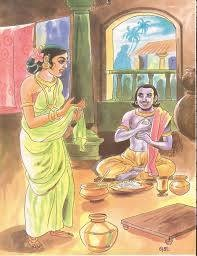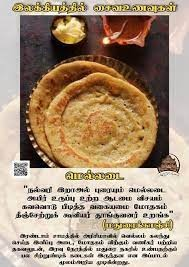"FOOD HABITS OF TAMILS" PART "பண்டைய
சங்க தமிழரின் உணவு பழக்கங்கள் தொடர்கிறது" "Food Habits of Ancient Sangam Tamils continuing"
[ஆங்கிலத்திலும் தமிழிலும் / In English and
Tamil]
பண்டைய தமிழர் நிலம் ஐந்து திணைகளாகப் பிரிக்கப்பட்டு, அந்த அந்த திணைகளில் வாழும் மக்களின் உணவு முறை அவர்களின் உழைப்புக்கும் சூழலிற்கும் ஏற்ப இருந்தன என்பதை அறிகிறோம். முல்லை நிலத்து இடையர், பசுக்களையும் ஆடுகளையும் எருமைகளையும் வளர்த்தார்கள். ஆட்டுக்கறி, உடும்புக்கறி ஆகியவற்றை சமைத்தும், குச்சியில் கோர்த்து சுட்டும் உண்டனர். விருந்தினர் வந்தால், தினையும் பாலும் சேர்த்து சமைத்த சோறு பரிமாறினர். மற்றும் சோளம்,அவரை, துவரை, தயிர், மோர், நெய் போன்றவற்றையும் உண்டு மகிழ்ந்தனர். மருதத்தில், வாழ்ந்த விவசாயிகள், நெல்லு, கரும்பு, மற்றும் காய்கறி முதலான உணவுப் பொருள்களையும் பயிரிட்டார்கள். முல்லை மலர் போன்ற முனை முறியா அரிசி சோறு, கோழி பொரியல் ஆகியவற்றை வாழை இலை, ஆம்பல் இலையில் வைத்து உண்டனர். மற்றும் கஞ்சி, தேன், பால், நெய் போன்றவற்றுடன் சேர்த்து பலவகை பதார்த்தங்கள், மாம்பழம், பலாப்பழம், வாழைப்பழம், கரும்பு போன்றவற்றையும் உணவிற்கு பாவித்தனர். உலகத்திலே எல்லாத் தேசங்களிலும் மக்கள் நாகரிகம் பெற்ற இடம் ஆற்றங்கரைகளிலும் ஏரிக் கரைகளிலுந்தான் என்று வரலாறு கூறுகிறது. இது உண்மையே. தமிழ்நாட்டிலும் மக்கள் நாகரிகம் பெற்று வளர்ந்த இடம் ஆற்றங்கரைகளும் ஏரிக்கரைகளுமே. ஆகவே, இந்த மருத நிலத்து மக்கள் கட்டிடங்களையும் மாளிகைகளையும் அரண்மனைகளையும் அமைத்துக் கொண்டு நாகரிகமாகவும் நன்றாகவும் வாழ்ந்தார்கள்.
நெய்தல்
நிலம்,
ஒரு
மணல்
நிலம்
ஆகையினால்
இங்கே
நெல்,
கேழ்வரகு
முதலான
தானியங்கள்
விளையவில்லை.
ஆகவே
நெய்தல்
நிலத்து
மக்கள்
கட்டுமரங்களிலும்
படகுகளிலும்
கடலில்
வெகு
தூரம்
போய்
வலைவீசி
மீன்
பிடித்தார்கள்.
கடலில்
சுறா,
இறால்,
திருக்கை
முதலான
மீன்
வகைகள்
அவர்களுக்கு
உணவாக
அங்கு
கிடைத்தன.
அவற்றைப்
பிடித்து
வந்து,
தேவைக்கு
அதிகமானவற்றை,
அயல்
ஊர்களில்
பண்டமாற்று
செய்து,
அதற்குப்
பதிலாக
தானியங்களைப்
பெற்றார்கள்.
மேலும்
இவர்கள்
அகன்ற
வாயை
உடைய ஜாடிகளில் வைக்கப்பட்டிருந்த
அரிசி
கஞ்சி
அல்லது
வடிசாறையும்
கள்ளையும்
குடித்தார்கள்.
குறிஞ்சி
நில
குறவர்,
மலைகளிலும்
மலைச்
சாரல்களிலும்
நிலத்தை
ஏரினால்
உழாமல்
மண்வெட்டியால்
கொத்திக்
கிளறி
ஐவன
நெல்லையும்,
தினையையும்
அரிசியையும்,
மற்றும்
பழங்கள்,
காய்கறி
பயிர்
செய்தார்கள்.
மலையுச்சியிலுள்ள
பாறைகளில்
மலைத்தேன்
கிடைத்தது.
வள்ளிக்
கிழங்கு
பயிராயிற்று.பலா
மரங்களிலே
பலாப்பழங்கள்
கிடைத்தன.
மற்றும்
ஆட்டுக்கடா
இறைச்சியும்
அரிசியில்
அல்லது
தினை
யரிசியிலிருந்து
வடிக்கப்பட்ட
ஒரு
வகை
கள்ளையும்
குடித்தனர்.
அத்துடன்
தேனை
மூங்கிற்
குழாய்களில்
ஊற்றிப்
பதப்படுத்தி
ஒருவகை
மதுவை
உண்டாக்கினார்கள்.
பாலை
நில
வேடுவர்,
சிவப்பு
அரிசியும்
வேட்டையாடிய
விலங்குகளையும்
பொதுவாக
உண்டனர்.
இவர்கள்
சிலவேளை
கடன்
வாங்கி
"கள்"
குடித்தும்
உள்ளனர்
என்பதை
சங்க
பாடல்
மூலம்
அறிகிறோம்.
சங்க
காலத்தில்,
தமிழ்க்குடி
என்று
அனைவராலும்
போற்றப்படும்
தமிழ்
மக்களின்
பண்பாட்டில்
விருந்தோம்பல்
சிறப்பு
மிக்கதாகும்.
அங்கு
பணக்கார
மற்றும்
ஏழை
மக்கள்,
இருவரும்
விருந்தினர்களை
புன்முறுவலுடன்
உபசரித்தனர்.
ஆனால்
இப்போது
அதன்
சிறப்பு
குறைந்து
கொண்டே
வருகின்றது.
"விருந்தினரைக்
கண்டால்
அவர்களுக்கு
ஒன்றும்
அளிக்க
முடியாததால்
ஒளிந்து
கொள்கிறேன்.
என்
அறிவும்
தடுமாற்றம்
அடைகிறது"
- என
புறநானுறு
266, வரிகள்,
11-13,
"விருந்துகண்டு
ஒளிக்கும்
திருந்தா
வாழ்க்கைப்,
பொறிப்புணர்
உடம்பில்
தோன்றிஎன்,
அறிவுகெட
நின்ற
நல்கூர்
மையே." என்று கூறுவதில்
இருந்து
அதன்
சிறப்பை
அறிய
முடிகிறது.
மகிழ்ச்சி
நிரம்பிய
விழாக்களில்,
அரசனும்
செல்வந்தரும்,
பொதுமக்களுக்கு
பல
வகை
இனிக்கும்
ஆகாரம்
வழங்கினர்.
இப்படி
இவர்கள்
கொடுத்த
உணவு
வகைகளைப்
பற்றி,
2000 ஆண்டுகளுக்கு
முற்பட்ட
சங்க
பாடல்கள்
வர்ணிக்கின்றன.
இந்த
பாடல்கள்,
பொது
மக்களின்
உணவையும்
மற்றும்
அரண்மனை
விழாக்களில்,
கொண்டாடங்களில்,
திருமண
விழாக்களில்
சமைக்கப்பட்ட
உணவையும்
எடுத்து
கூறுகின்றன.
பண்டைய
தமிழ்
இலக்கியம்,
கி
மு
700 இல்
இருந்து
அறியப்பட்டு
இருந்தாலும்,
கி
மு
300 - கி
பி
300 இடைப்பட்ட
ஆண்டிலேயே
தமிழரின்
உணவு
பண்பாடு
பற்றி
சங்க
இலக்கியத்தில்
அறியமுடிகிறது.
"கடல் இறவின்
சூடு
தின்றும்
வயல்
ஆமைப்
புழுக்கு
உண்டும்"
[63-64] மற்றும்
“மீன்
தடிந்து
விடக்கு
அறுத்து
ஊன்
பொரிக்கும்
ஒலி
முன்றில்”
[177-178] போன்ற
பட்டினப்பாலை
அடிகள்,
அங்கு
வறுத்த
இறாலையும்
வேகவைத்த
ஆமையையும்
உண்டார்கள்
என்பதையும்,
பூம்புகாரின்
அங்காடித்
தெருவில்
அமைந்து
உள்ள
மதுபானக்
கடை
முற்றத்தில்,
மீனையறுத்துப்
பின்
இறைச்சியையுமறுத்து
அவ்விரண்டு
தசையினையும்
பொரிக்கும்
ஆரவாரத்தையும்
தெட்டத்
தெளிவாக
அது
எடுத்து
கூறுகிறது.
மேலும்
விளைந்த
நெல்லை
- மழலைக்குக்
கஞ்சி,
வளரும்
பிள்ளைக்கு
பச்சரிசி,
பெரியவருக்கு
கைக்குத்தல்
புழுங்கல்,
பாட்டிக்கு
அவல்,
மாலை
சிற்றுண்டியாக
பொரி,
என
நெல்லை
தேவைக்
கேற்றபடி
தயாரிக்கவும்
அறிந்து
இருந்தது
மட்டுமல்ல,
இனிப்பு
கலந்த
பாலில்
நனைத்த
அரிசி
அப்பமும்,
நீண்ட
வெள்ளை
சரங்களை
போன்று
அவிக்கப்
பட்ட
இடி
அப்பமும்
பெரும்பாணாற்றுப்படை,
மதுரைக்
காஞ்சி,
சிலப்பதிகாரம்
போன்ற
இலக்கியங்களில்
கூறப்
பட்டுள்ளது.
என்றாலும்
இன்று
அவிப்பது
போன்ற
நீராவியில்
சமைத்த
வட்ட
வடிவ
இடியப்பம்
அன்று இருக்கவில்லை.
நன்றி
[கந்தையா
தில்லைவிநாயகலிங்கம்,
அத்தியடி, யாழ்ப்பாணம்]
பகுதி : 22 தொடரும்…
👉அடுத்த பகுதியை வாசிக்க அழுத்துக
Theebam.com: "தமிழரின் உணவு பழக்கங்கள்"-பகுதி: 22:
👉ஆரம்பத்திலிருந்து வாசிக்க அழுத்துக
"FOOD
HABITS OF TAMILS" PART: 21
"Food
Habits of Ancient Sangam Tamils continuing"
We know that the ancient Tamil land was divided into five
divisions and the diet of the people living in those divisions was according to
their labor and environment. The herdsmen of mullai (forest tracks) region
raised cows, goats and buffaloes. They ate lamb and iguana cooked and grilled.
If a guest came, rice cooked with millet and milk was served. And they enjoyed
eating corn, Lablab purpureus [is a species of bean / avarai], The pigeon pea
(Cajanus cajan / is a perennial legume / Tuvarai) , curd, buttermilk, ghee etc.
In marudham, Farmers cultivated food items such as paddy, sugarcane, and
vegetables. They ate end unbroken rice and fried chicken on banana leaves and the
water lily [ambal] leaves. And along with porridge, honey, milk, ghee etc.,
they used to eat various foods like mango, jackfruit, banana, sugarcane etc.
History tells us that people in all countries of the world have been civilized
on the banks of rivers and lakes. In Tamil Nadu too, the people have been
civilized on the banks of rivers and lakes. So the people of this marudham land
built buildings, mansions and palaces and lived civilized and well.
The Neidhal land is a sandy land, so grains such as paddy
and millet are not grown here. So the people of Neythal land went far out into
the sea in rafts and boats and caught fish. Fish like sharks, prawns, and
shrimps. Whatever extra, they bartered them in the neighboring towns for grain
in return. And they drank rice gruel or toddy [Arici kañci, vaṭicāṟaiyum
kaḷḷaiyum / Rice porridge or the naturally alcoholic sap of some kinds of palm,
used as a beverage in tropical countries] kept in wide-mouthed jars. The
Kurinji land cultivator used to plow the land in the hills and slope of hills
only with a spade and cultivated crops of paddy [Mountain paddy, wild rice / ஐவன
நெல்
Aivaṉa nel], millet and rice [Arici], and fruits and vegetables. Mountain honey
was found on the rocks at the top of the hill. Sweet potato was grown.
Jackfruits were found. And they had
mutton and drank toddy, distilled from rice or a type of millet. They also
poured honey into bamboo pipes and processed it to make a kind of wine. In
Palai land, Veddas usually ate red rice and wild animals meat hunted by them.
We learn from the Sangam poems that Veddas sometimes take loans from others and
drank toddy.
Hospitality was considered virtue and both the rich and the
poor delighted in serving their guests, and ate what was left. In Purananuru
266, lines,11-13,The poet requests the king to help him immediately to remove
his poverty. He feels his poverty is shameful that made him hide him while the
host approaches as:
"O Chenni with strong horses! Please grant me rapid relief from this
poverty, like you are listening to a request for help in an assembly of noble
men. My thoughts are muddied within my body with all the senses, my life is
twisted, and I hide myself whenever I see my guests!" On festive occasions the king and the rich
held free feasts and several delicacies were offered. The food that the king
provided to his court poets, soldiers and subjects is often descried in detail
in over 2000 years olds Sangam poems. Several of these poems describe of foods
of the common people and feasts that were prepared and served at the palaces,
at festivals, and at weddings. Though, the earliest Tamil writings are traced
to about 700 BC, but references to edibles and food habits abound in literature
between 300 BC and 300 AD.
Pattinap - Palai mentions fish being sliced at the port of
Pukar in the mouth of the Kaveri, and fishermen partaking of dishes of fried
sweet prawns and boiled field tortoise. The staple food of the Tamils then as
now seems to have been rice, supplemented with various vegetables and meats.
Milk, butter and honey also seem to have been in common use. Many forms of rice
were already known, like parched or flattened rice, puffed rice [is made by
heating rice in a sand-filled oven], and parboiled rice [is rice that has been
partially boiled in the husk]. Rice appam, a pancake soaked in sweetened milk
was already well established and Idi-appam, cooked rice in the form of long
white strings rather like fine noodles, is also mentioned even at this early
date in ancient Sangam poems Perumpanattuppadai, Mathuraikanchi and
Silappathikaram. However, Idiyappam, as traditionally known as fresh
steam-cooked, a circular pattern fine rice noodles was not existed at that
time.
Thanks
[Kandiah Thillaivinayagalingam,Athiady,
Jaffna]
PART : 22 WILL FOLLOW






No comments:
Post a Comment